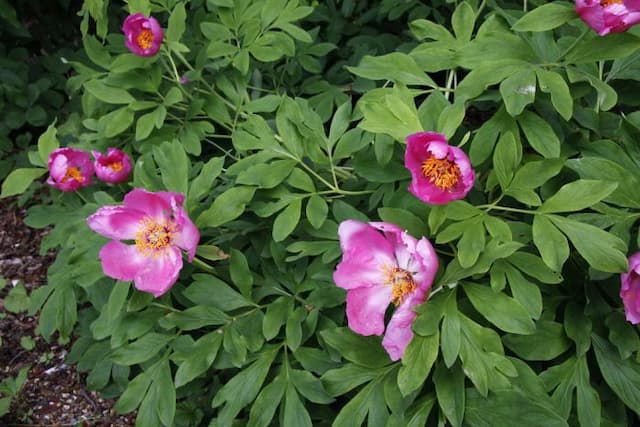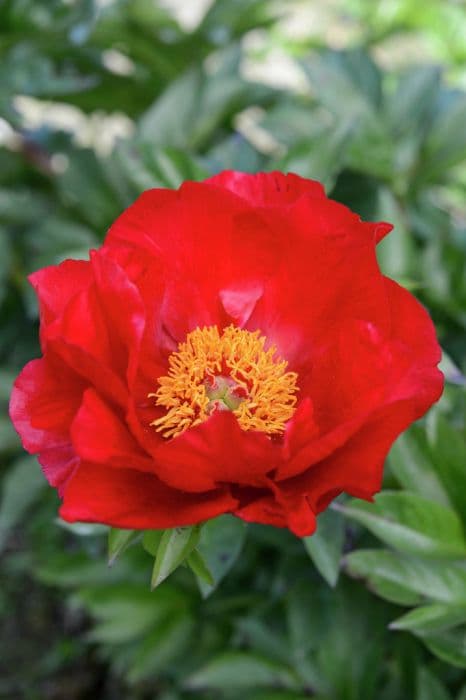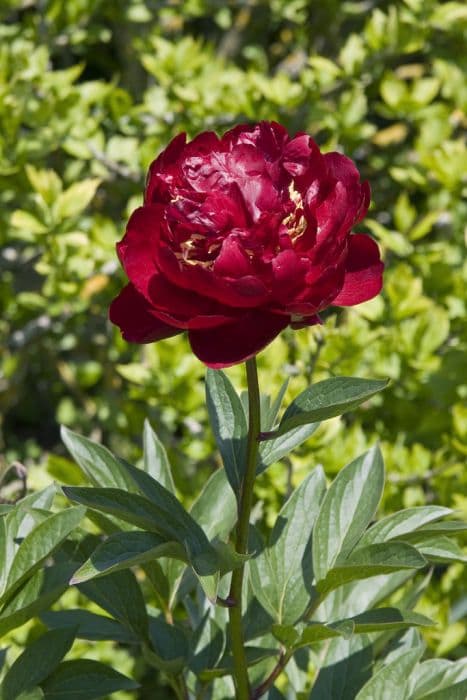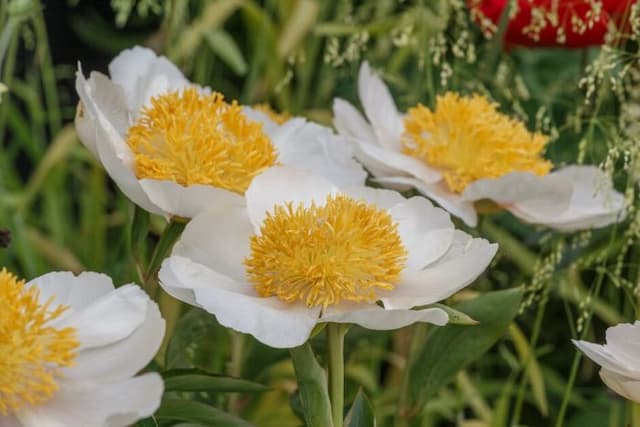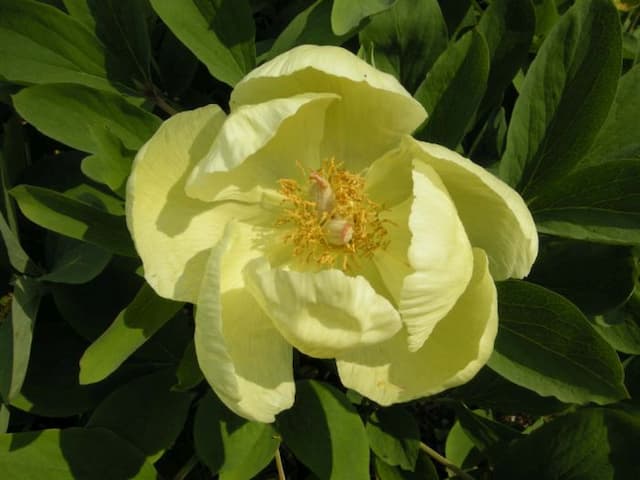Chinese Peony Paeonia lactiflora 'Madame Gaudichau'

ABOUT
Madame Gaudichau peony features large, double flowers characterized by a unique blend of pink tones that can range from a soft baby pink to a deeper, almost fuchsia shade. The blooms are rounded, full, and can often present a slight silvery sheen to the petals, which are densely packed and may exhibit a ruffled or slightly curled appearance at the edges, giving a lush, luxurious feel. At the core of the flower, a cluster of golden-yellow stamens may be visible, offering a stunning contrast against the pink petals and drawing in pollinators. The flowers are notably fragrant, emitting a delightful scent that can fill a garden space, especially on warm days. The foliage of Madame Gaudichau peony is a rich, deep green color that provides a striking backdrop for the showy flowers. The leaves are glossy and often have a somewhat leathery texture, with a broad, lance-shaped to ovate form. They are arranged alternately along the stems, which are sturdy and upright, ensuring that the large flowers are well-supported. Throughout the blooming season, which typically occurs in late spring to early summer, Madame Gaudichau peony maintains a stately and elegant presence in the garden. Its striking flowers and contrasting foliage make it a favorite among garden enthusiasts and a popular choice for cut flower arrangements, bringing a touch of classic beauty to both landscapes and indoor settings.
About this plant
 Names
NamesFamily
Paeoniaceae
Synonyms
Chinese Peony, White Peony
Common names
Paeonia lactiflora 'Madame Gaudichau'.
 Toxicity
ToxicityTo humans
The common name for Paeonia lactiflora 'Madame Gaudichau' is the peony. Peonies are generally not considered highly toxic to humans, and while they are not meant to be ingested, accidentally consuming small amounts of the plant typically does not result in severe poisoning. However, some parts of peonies contain compounds that might cause gastrointestinal upset if ingested in significant quantities, with possible symptoms including nausea, vomiting, and diarrhea. In rare cases, more serious effects could occur, especially if large amounts are consumed.
To pets
Peonies, the common name for Paeonia lactiflora 'Madame Gaudichau', are considered mildly toxic to pets, including cats and dogs. The consumption of any part of the plant could lead to gastrointestinal irritation and may manifest symptoms such as vomiting or diarrhea. It is advisable to keep pets away from peonies to prevent these adverse reactions. However, the toxicity is generally considered to be low, and serious consequences are rare when only small amounts are ingested.
 Characteristics
CharacteristicsLife cycle
Perennials
Foliage type
Deciduous
Color of leaves
Green
Flower color
Pink
Height
2-3 feet (60-90 cm)
Spread
2-3 feet (60-90 cm)
Plant type
Herb
Hardiness zones
3-8
Native area
Asia
Benefits
 General Benefits
General Benefits- Aesthetic Appeal: Paeonia lactiflora 'Madame Gaudichau', commonly known as Peony, offers large, fragrant pink flowers that enhance the beauty of gardens and landscapes.
- Longevity: Peonies have a long lifespan, often living for decades and becoming more prolific over the years.
- Seasonal Interest: This type of Peony blooms in late spring or early summer, providing a seasonal display of color when many other plants are just starting to grow.
- Easy to Grow: Peonies are relatively low maintenance, requiring minimal care once established in a suitable environment.
- Cut Flowers: Peonies are excellent for cutting gardens as they have long-lasting, showy flowers that are ideal for bouquets and arrangements.
- Attracts Pollinators: The vivid blooms attract bees, butterflies, and other beneficial pollinators, supporting local ecosystems.
- Drought Resistance: Once established, Peonies can be quite drought-tolerant, making them suitable for a variety of climate conditions.
- Deer Resistance: Peonies are generally not preferred by deer, reducing the likelihood of damage from wildlife browsing.
 Medical Properties
Medical Properties- Anti-inflammatory: Paeonia lactiflora has been traditionally used in herbal medicine to help reduce inflammation.
- Analgesic: It may have pain-relieving properties that help in alleviating discomfort.
- Immunomodulatory Effects: The root of Paeonia lactiflora is believed to possess properties that can modulate the immune system.
- Antioxidant: This plant contains compounds that are thought to exhibit antioxidant effects, helping to combat oxidative stress in the body.
- Antispasmodic: Paeonia lactiflora may help to relieve muscle spasms and cramps.
- Anxiolytic: Some components in Paeonia lactiflora could potentially aid in reducing anxiety.
- Neuroprotective: The root extract has been studied for its potential neuroprotective effects that might be beneficial for nervous system health.
- Cardiovascular Health: Paeonia lactiflora might contribute to cardiovascular health by improving blood flow and reducing blood clotting.
- Hepatoprotective: There is some evidence to suggest that it may offer protection against certain types of liver damage.
- Menstrual Discomfort: The plant has been used to ease menstrual cramps and regulate menstruation.
 Air-purifying Qualities
Air-purifying QualitiesThis plant is not specifically known for air purifying qualities.
 Other Uses
Other Uses- The petals of peonies can be used to make natural dyes for fabrics, yielding soft pinks and creamy hues, depending on the mordant used.
- Peony blossoms are sometimes used in gourmet dishes, either as edible garnishes or infused into syrups to impart a floral flavor to desserts and cocktails.
- The peony's large, showy flowers can be used in art projects, including pressed flower crafts or as a natural source of pigment for botanical paintings.
- In some cultures, peony seeds were traditionally worn as beads in jewelry as a symbol of beauty and elegance.
- Peony petals can serve as a non-toxic colorant in homemade soaps, providing a gentle hue and a subtle fragrance.
- The plants themselves are used as ornamentals to create focal points in landscape design, adding a luxurious element to gardens and parks.
- Peonies can be floated in large bowls of water as a decorative centerpiece for events or as a fragrant and elegant touch in home décor.
- Used in perfumery, the bloom's essence is captured to create perfumes with lush, romantic fragrances that evoke the essence of a springtime garden.
- Peony flowers can be made into a natural potpourri when dried, filling a room with a delicate scent when combined with other dried botanicals.
- The tough stems and foliage of peonies are sometimes used in compost piles, contributing to soil health once they decompose and enrich the garden ecosystem.
Interesting Facts
 Feng Shui
Feng ShuiThe Peony is often used in Feng Shui to promote love and romance as it is considered the 'flower of riches and honor.' It is recommended to place Peony plants or flowers in the southwest corner of the garden or home, as this is connected to the love and marriage area according to the Bagua map.
 Zodiac Sign Compitability
Zodiac Sign CompitabilityThe Peony is not used in astrology practice.
 Plant Symbolism
Plant Symbolism- Romance and Love: The Peony, known for its lush and full blooms, is often considered a symbol of romance and love. The 'Madame Gaudichau' variety, with its beautiful flowers, enhances this association.
- Prosperity and Good Fortune: Peonies are traditionally linked with prosperity and good fortune. Their full, rounded blooms are associated with wealth and success, making them popular in celebrations and weddings.
- Compassion: Peonies can signify compassion. Their gentle appearance invokes a sense of empathy and caring, suggesting the presence of heartfelt kindness.
- Beauty and Femininity: With their delicate, layered petals, peonies have long been a symbol of beauty and femininity. The 'Madame Gaudichau' Peony, with its attractive form and color, accentuates these qualities.
- Honor and Respect: In some cultures, peonies are seen as a token of honor and respect. The giving of a peony can imply high value and esteem for the recipient.
- Happy Marriage: Due to their connections with love and prosperity, peonies like 'Madame Gaudichau' are often seen as good omens for a long and happy marriage.
 Water
WaterPeonies, including the 'Madame Gaudichau' variety, require watering that keeps the soil evenly moist but not waterlogged. During the growing season, water them once a week with about 1 inch of water. This could be around 0.62 gallons for a medium-sized plant. Increase the frequency during hot and dry periods but allow the soil to dry out slightly between waterings. Water at the base of the plant to avoid wetting the foliage, which can lead to fungal diseases.
 Light
LightPeonies like 'Madame Gaudichau' flourish in full sun to partial shade. They require at least six hours of sunlight per day to bloom properly. The ideal location would be one where the plant receives morning sun and afternoon shade, protecting it from the intense late-day heat.
 Temperature
Temperature'Madame Gaudichau' peonies prefer temperate climates and thrive best when the temperature ranges from 65°F to 75°F during the growing season. They are hardy and can survive winter temperatures down to -20°F, but may not tolerate extended periods above 85°F during active growth.
 Pruning
Pruning'Madame Gaudichau' peonies should be pruned to remove spent flowers after blooming to encourage healthy growth and improve appearance. In fall, cut back the foliage to the ground after the first frost to prevent overwintering diseases. Pruning is not needed in the spring or during active growth unless to remove damaged stems.
 Cleaning
CleaningAs needed
 Soil
SoilPeonies prefer well-draining soil with a pH of 6.5 to 7.0. A mix of two parts garden soil, one part compost, and one part perlite or sand is ideal for ensuring adequate drainage and fertility. Amend the soil with organic matter each year to maintain nutrient levels.
 Repotting
RepottingPeonies, including the Madame Gaudichau, are typically not repotted often as they are perennial plants that are planted outdoors. Instead, they should be divided every few years if they become overcrowded, usually every 3 to 5 years.
 Humidity & Misting
Humidity & MistingPeonies like Madame Gaudichau prefer average garden humidity levels. They are quite adaptable and do not require specific humidity conditions, making them suitable for most temperate climates without the need for humidity adjustments.
 Suitable locations
Suitable locationsIndoor
Provide bright light and cool temperatures over winter for indoor peonies.
Outdoor
Plant in full sun to partial shade in spring or fall, water deeply.
Hardiness zone
3-8 USDA
 Life cycle
Life cycleThe Paeonia lactiflora 'Madame Gaudichau', commonly known as Chinese Peony, begins its life as a seed which germinates in late winter or spring, developing a small root system and initial shoots. The plant enters a vegetative stage, producing a set of compound leaves on stout stems that grow throughout the spring. By late spring to early summer, the Chinese Peony enters the flowering stage, blooming with large, showy flowers that can be pink, red, white, or multi-colored, depending on the cultivar. After pollination, typically by insects, the plant produces seeds in the form of a dry fruit, which are dispersed when mature, in late summer or early fall. During the fall, the above-ground parts of the plant die back, with the peony entering a period of dormancy through the winter, conserving energy in its root system. The cycle recommences the following spring, when the plant emerges again from the surviving underground roots, ready to grow and bloom in the new season.
 Propogation
PropogationPropogation time
Spring
The most popular method of propagation for the peony 'Madame Gaudichau' is by division. This is typically done in the fall, after the plants have finished blooming and are entering dormancy. To propagate by division, the plant clumps should be carefully dug up, taking care to do minimal damage to the roots. The clumps are then divided into smaller sections, ensuring that each division has at least 3-5 buds or 'eyes'. The divisions are replanted at a depth such that the eyes are about 1-2 inches (2.5-5 centimeters) below the soil surface, spaced 2-3 feet (0.6-0.9 meters) apart to allow room for growth. Proper watering and avoidance of deep planting are crucial for the successful establishment of the new plants.
